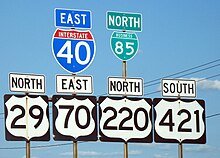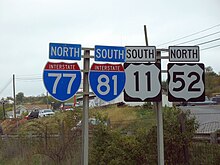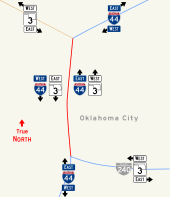Concurrency (road)

Aconcurrencyin a road network is an instance of one physical roadway bearing two or more differentroute numbers.[1]When two roadways share the sameright-of-way,it is sometimes called acommon sectionorcommons.[2]Other terminology for a concurrency includesoverlap,[3]coincidence,[4]duplex(two concurrent routes),triplex(three concurrent routes),multiplex(any number of concurrent routes),[5]dual routingortriple routing.[6][7]
Concurrent numbering can become very common in jurisdictions that allow it. Where multiple routes must pass between a single mountain crossing or over a bridge, or through a major city, it is often economically and practically advantageous for them all to be accommodated on a single physical roadway. In some jurisdictions, however, concurrent numbering is avoided by posting only one route number on highway signs; these routes disappear at the start of the concurrency and reappear when it ends. However, any route that becomes unsigned in the middle of the concurrency will still be signed on most maps and road atlases.
Overview
[edit]Most concurrencies are simply a combination of at least two route numbers on the same physical roadway. This is often practically advantageous as well as economically advantageous; it may be better for two route numbers to be combined into one along rivers or through mountain valleys. Some countries allow for concurrencies to occur, however, others specifically do not allow it to happen. In those nations which do permit concurrencies, it can become very common. In these countries, there are a variety of concurrences which can occur.
An example of this is the concurrency ofInterstate 70(I-70) andI-76on thePennsylvania Turnpikein westernPennsylvania.I-70 merges with the Pennsylvania Turnpike so the route number can ultimately continue east into Maryland; instead of having a second physical highway built to carry the route, it is combined with the Pennsylvania Turnpike and the I-76 designation.[8]A triple Interstate concurrency is found in Wisconsin along the five-mile (8.0 km) section ofI-41,I-43,andI-894inMilwaukee, Wisconsin.[9]The concurrency of I-41 and I-43 on this roadway is an example of awrong-way concurrency.
The longest Interstate highway concurrency isI-80andI-90for 278 miles (447 km) acrossIndianaandOhio,while the longest Interstate highway concurrency with three interstates isI-39,I-90, andI-94inPortage, Wisconsinfor over 29 miles (47 km).[10]
There are at least two examples of eight-way concurrencies. The first example is inIndianapolis,between exits 46 and 47 of the 53-mile (85 km)I-465beltway,where the highway is concurrent withU.S. Route 31(US 31),US 36,US 40,US 52,US 421,State Road 37(SR 37), andSR 67.[11]OnceI-69is extended south of Indianapolis, this segment will have a nine-way concurrency. The second example is indowntown Athens, Georgia,between exits 4 and 8 ofGeorgia State Route 10 Loop,where the highway is concurrent withUS 29,US 78,US 129,US 441,State Route 8(SR 8),SR 15,andSR 422.[12]
Regional examples
[edit]North America
[edit]
In the United States, concurrencies are simply marked by placing signs for both routes on the same or adjacent posts. The federalManual on Uniform Traffic Control Devicesprescribes that when mounting these adjacent signs together that the numbers will be arranged vertically or horizontally in order of precedence. The order to be used isInterstate Highways,U.S. Highways,state highways,and finallycounty roads,and within each class by increasing numerical value.[13]
Several states do not officially have any concurrencies, instead officially ending routes on each side of one.[a]There are several circumstances where unusual concurrencies exist along state borders. One example occurs along theOklahoma–Arkansasstate line. At the northern end of this borderOklahoma State Highway 20runs concurrently withArkansas Highway 43and the two highways run north–south along the boundary.[15]

Concurrencies are also found in Canada.British Columbia Highway 5continues east for 12 kilometres (7.5 mi) concurrently withHighway 1andHighway 97,throughKamloops.This stretch of road, which carries Highway 97 south and Highway 5 north on the same roadway (and vice versa), is the only wrong-way concurrency in British Columbia. Concurrencies are also very common inQuebec.Most notably, theSamuel-de-Champlain Bridgefeatures a concurrency with three Autoroutes:A-10,A-15,andA-20.Another example isA-55,which runs concurrently with A-10, A-20, andA-40,all of which are major highways.
InOntario,theQueen Elizabeth WayandHighway 403run concurrently betweenBurlingtonandOakville,forming the province's only concurrency between two400-series highways.[16]The concurrency was not in the original plan which intended for both the QEW and Highway 403 to run parallel to each other, as the Hamilton–Brantford and Mississauga sections of Highway 403 were initially planned to be linked up along a corridor (later planned to betolled) now occupied byHighway 407.To avoid forcing drivers to pay tolls to use a section of a continuous Highway 403, the new link was designated as a western extension of the tolled Highway 407, with the Mississauga section of Highway 403 planned to be renumbered as Highway 410. The renumbering to 410 never came to pass,[17]and consequently Highway 403 was signed concurrently along the Queen Elizabeth Way in 2002, remedying the discontinuity. Nonetheless, many surface street signs referring to that section of freeway with the QEW/Highway 403 concurrency still only use the highway's original designation of QEW, although the MTO has updated route markers on the QEW to reflect the concurrency.[18]
At the national level, theTrans-Canada Highway,which does not bear a uniform number in the eastern provinces, follows various provincial highways. In theAtlantic Provincesthe main designated TCH route either follows a single numbered route across each province (an exception being the switching of the designation betweenNova Scotia Highways 104and105), or has branches that are signed exclusively as TCH routes. In Ontario and Quebec, The TCH follows a series of provincial highways, and also has branches that follow sections of others that have concurrencies with it, signed with TCH shields alongside the provincial number.
Europe
[edit]

In the United Kingdom, routes do not run concurrently with others. Where this would normally occur, the roadway takes the number of only one of the routes (usually, but not always, the most important route), while the other routes are considered to have a gap and are signed in brackets (the equivalent of "to" signs in North America). An example is the meeting of theM60and theM62northwest ofManchester:the motorways coincide for the seven miles (11 km) between junctions 12 and 18 but the motorway between those points is only designated as the M60 (although in this case the same junction numbers would also apply to the M62).European routenumbers as designated byUNECEmay have concurrencies (for instanceE15andE30aroundGreater London), but since the E-route numbers are unsigned and unused in the UK, the existence of these concurrencies is purely theoretical.
In Sweden and Denmark, the most important highways use only the European route numbers that have cardinal directions. In Sweden theEuropean route E6andE20run concurrently for 280 kilometres (170 mi). In Denmark theE47andE55run concurrently for 157 kilometres (98 mi). There are more shorter concurrencies. There are two stretches in Sweden and Denmark where three European routes run concurrently; these are E6, E20 andE22in Sweden, and E20, E47, and E55 in Denmark. Along all these concurrencies, all route numbers are posted with signs.[19]
In the Czech Republic, the European route numbers are only additional, and they are always concurrent with the state route numbering, usually highways or first-class roads. In the state numbering system, concurrences exist only in first-class and second-class roads; third class roads do not have them. The local term for such concurrences ispeáž(from the French wordpéage). In the road register, one of the roads is considered the main ( "source" ) road and the others as thepéaging(guest) roads. The official road map enables a maximum of five concurrent routes of the intrastate numbering system.[20]Cycling routes and hiking routes are often concurrent.
The Middle East
[edit]In Israel, twofreeways,theTrans-Israel Highway(Highway 6), andHighway 1run concurrently just east ofBen Shemen Interchange.The concurrency is officially designated "Daniel Interchange",providing half of the possible interchange directions. It is a one-mile (1.6 km) segment consisting of eight lanes providing high-speed access between the two highways. Access from Highway 1 west to Highway 6 south and Highway 6 north to Highway 1 east is provided viaRoute 431,while access between Highway 1 east to Highway 6 north and Highway 6 south to Highway 1 west are provided at Ben Shemen Interchange. The other movements are provided through the concurrency.[21]
Wrong-way concurrencies
[edit]

Since highways in the United States and Canada are usually signed with assignedcardinal directionsbased on their primary orientation, it is possible for a stretch of roadway shared between two highways to be signed with conflicting, even opposite, cardinal directions in awrong-way concurrency.[citation needed]For example, nearWytheville, Virginia,there is a concurrency betweenInterstate 77(which runs primarily north–south, as it is signed) andInterstate 81(which runs primarily northeast–southwest, but is also signed north–south). A vehicle might simultaneously be on I-77 northbound and I-81 southbound, while actually traveling due westbound.[22]An unusual example of a three-directional concurrency occurs southeast ofRhinelander, Wisconsin,whereUS 8westbound (the actual compass direction) converges with southboundWisconsin Highway 17and northboundWisconsin Highway 47,and vice-versa.[23]
Effect on exit numbers
[edit]Often when two routes withexit numbersoverlap, one of the routes has its exit numbers dominate over the other and can sometimes result in having two exits of the same number, albeit far from each other along the same highway. An example of this is from the concurrency ofI-94andUS 127nearJackson,Michigan. The concurrent section of freeway has an exit withM-106,which is numbered exit 139 using I-94's mileage-based numbers. US 127 also has another exit 139 with the southern end of theUS 127 business loopinMount Pleasant,Michigan. (US 127'smile markersin Michigan reflect the cumulative distance north of the Ohio state line; the numbers resume north of the I-94 overlap and reflect the distance accumulated on that concurrency.)[24]
However, there are also instances where the dominant exit number range is far more than the secondary route's highest exit number, for example theconcurrency of I-75 and I-85inAtlanta, Georgia—where I-75 is dominant—the exit numbers range from 242 to 251, while I-85's highest independentmile markerinGeorgiais 179.[25]
Consolidation plans
[edit]
Some brief concurrencies in the past have been eliminated by reassigning the designations along the roadways. This can involve scaling back the terminus of one designation to the end of a concurrent section. At the same time, there could be an extension of another highway designation that is used to replace the newly shortened designation with another one.
Between states,US 27in Michigan previously ran concurrently withI-69from the Michigan–Indiana state line to theLansing, Michigan,area. From there it turned northwards to its terminus atGrayling.In 1999, theMichiganandIndianadepartments of transportation petitioned theAmerican Association of State Highway and Transportation Officialsfor permission to truncate US 27 atFort Wayne, Indiana.[26]In 2002, Michigan removed the US 27 designation from I-69 and extended theUS 127designation from Lansing to Grayling.[27]MDOT's stated reason for the modification was to "reduce confusion along the US 27/US 127 corridor".[28]After US 27's signage was removed, the highway north of the Lansing area was renumbered US 127, and the US 27 designation was removed from I-69.[28]
Some consolidation schemes involve the use of incorporating two single-digit numbers onto one marker, as along theUS 1/9concurrency in northernNew Jersey.[29]In the mid-20th century,Californiahad numerous concurrencies, but theCalifornia Legislatureremoved most of them in acomprehensive reform of highway numbering in 1964.[30]
See also
[edit]Notes
[edit]- ^Arkansas's highways exist in many officially designated "sections" rather than form concurrencies.Arkansas Highway 131exists in five sections as an example.[14]
References
[edit]- ^Esri(March 4, 2014)."Realigning Concurrent Routes".ArcGIS Help 10.2 & 10.2.1.Esri.RetrievedApril 8,2014.
- ^"Freeway Flaws: Fixing Them May Take Decades".Star Tribune.Minneapolis. June 3, 2005.
common sections... 2 freeways share a single right-of-way
- ^Esri (December 19, 2012)."Realigning Overlapping Routes".ArcGIS Resource Center.Esri.RetrievedApril 8,2014.
- ^Office of Highway System Engineering (August 1995)."State Highway Routes Selected Information, 1994 with 1995 Revisions"(PDF).California Department of Transportation.Route 3. Archived fromthe original(PDF)on March 16, 2007.RetrievedMarch 7,2012.
Coincident with Rte 299
- ^Reichard, Timothy."Guide to Highway Multiplexes".Central PA/MD Roads.RetrievedApril 8,2014.
- ^Kanillopoolos, John J. (October 19, 1982)."Dual and Triple Routing on State Trunklines".Letter to Trunkline Numbering Committee. Lansing: Michigan Department of Transportation.RetrievedJune 3,2019– viaWikisource.
- ^Kanillopoolos, John J. (March 17, 1983)."Dual and Triple Routing on State Trunklines".Letter to Trunkline Numbering Committee. Lansing: Michigan Department of Transportation.RetrievedJune 3,2019– via Wikisource.
- ^Pennsylvania Department of TransportationGeographic Information Section (2010).Tourism & Transportation Map(Map). Scale not given. Harrisburg: Pennsylvania Department of Transportation. §§ E10–L11.
- ^Srubas, Paul (April 9, 2015)."It's Officially Interstate 41 Now in Wisconsin".Green Bay Press-Gazette.RetrievedMay 27,2015.
- ^Federal Highway Administration(December 31, 2013)."Table 1: Main Routes of the Dwight D. Eisenhower National System of Interstate and Defense Highways as of December 31, 2013".Route Log and Finder List.Federal Highway Administration.RetrievedApril 8,2014.
- ^Indiana Department of Transportation(2007).Indiana Transportation Map(Map) (2007–08 ed.). Scale not given. Indianapolis: Indiana Department of Transportation. Indianapolis inset.
- ^Georgia Department of Transportation(2021).General Highway Map, Clarke County, Georgia(PDF)(Map). 1:31,680.
- ^Federal Highway Administration (2009)."Chapter 2D. Guide Signs: Conventional Roads, §2D.29: Route Sign Assemblies"(PDF).Manual on Uniform Traffic Control Devices(Revisions 1&2, 2009 ed.). Washington, DC: Federal Highway Administration. p. 148.ISBN9781615835171.RetrievedDecember 20,2014.
- ^Planning and Research Division (April 2010).State Highways 2009(Database).Arkansas State Highway and Transportation Department.Archived fromthe original(ZIP)on July 7, 2011.RetrievedApril 11,2011.
- ^Arkansas State Highway and Transportation Department Planning and Research Division (2010).State Highway Map(Map). 1:950,400. Little Rock: Arkansas State Highway and Transportation Department. § A1.
- ^Ministry of Transportation of OntarioGeomatics Office (2010).Official Road Map / Carte Routière(Map) (2010–11 ed.). 1:250,000 (in English and French). Toronto: Ministry of Transportation of Ontario. § R25.
- ^Mitchell, Bob (April 6, 1995). "Rae Announces 407 Extension".Toronto Star.p. BR03.
- ^"Signs of the Times".Milestones.2(1). Ontario Good Roads Association: 26, 31. February 2002. Archived fromthe originalon April 26, 2012.RetrievedJanuary 2,2012.
- ^Check Google Streetview at55°33′00″N13°03′06″E/ 55.5500993°N 13.0517037°E,55°34′48″N12°15′42″E/ 55.5800398°N 12.2615534°Eand neighboring locations[full citation needed]
- ^"Číslo peažující silnice], explanatory notes to the road map, Ředitelství silnic a dálnic"(in Czech). Directorate of Roads and Highways. Archived fromthe originalon 2015-05-18.Retrieved2015-05-17.[full citation needed]
- ^עורכת אחראית אלנה בלינקי; Elena Belinki (2014).2014 אטלס הזהב[Atlas HaZahav 2014] (in Hebrew) (9th ed.). מפה הוצאה לאור [Mapa Publishing].ISBN978-965-521-136-8.Archived fromthe originalon 2014-07-14.Retrieved2014-06-08.
- ^Virginia Department of Transportation(2012).Official State Transportation Map(Map) (2012–14 ed.). c. 1:832,680. Richmond: Virginia Department of Transportation. §§ F6–G6.
- ^Google(November 2022)."4910 WI-17, Rhinelander, Wisconsin".Google Street View.Google.RetrievedFebruary 19,2024.
- ^Michigan Department of Transportation(2013).Pure Michigan: State Transportation Map(Map). c. 1:975,000. Lansing: Michigan Department of Transportation. §§ J10, M11.OCLC42778335,861227559.
- ^Georgia Department of Transportation(2011).Official Highway and Transportation Map(PDF)(Map) (2011–2012 ed.). Scale not given. Atlanta: Georgia Department of Transportation. Main map, §§ B1, I2; Atlanta inset, § E5.OCLC770217845.
- ^Special Committee on U.S. Route Numbering (April 17, 1999)."Report of the Special Committee on U.S. Route Numbering to the Standing Committee on Highways"(PDF)(Report). Washington, DC:American Association of State Highway and Transportation Officials.Archived fromthe original(PDF)on October 16, 2017.RetrievedMay 24,2008.
- ^Ranzenberger, Mark (April 27, 2008)."US 127 Signs Getting Updated".The Morning Sun.Mount Pleasant, MI. pp. 1A, 6A.OCLC22378715.RetrievedAugust 23,2012– viaNewsBank.
- ^abDebnar, Kari & Bott, Mark (January 14, 2002)."US 27 Designation Soon To Be Deleted from Michigan Highways"(PDF)(Press release). Michigan Department of Transportation.
- ^New Jersey Department of Transportation.Signage for US 1/9, NJ 21, US 22, and I-78(Highway guide sign). Newark, NJ: New Jersey Department of Transportation.RetrievedDecember 5,2009.
- ^"Route Renumbering: New Green Markers Will Replaces Old Shields"(PDF).California Highways and Public Works.43(1–2): 11–14. March–April 1964.ISSN0008-1159.RetrievedMarch 8,2012.
External links
[edit]![]() Media related toConcurrencyat Wikimedia Commons
Media related toConcurrencyat Wikimedia Commons
